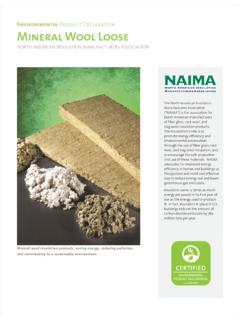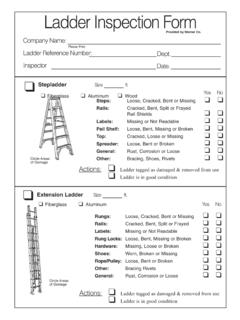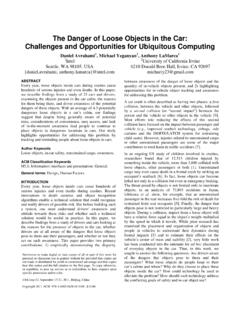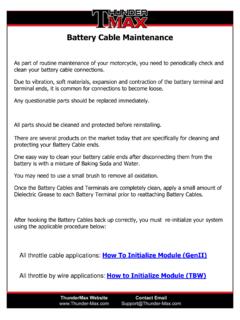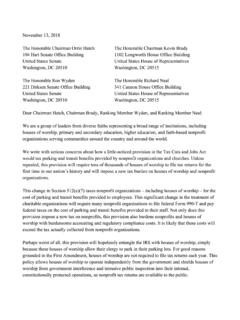Transcription of by Sandra McClintic Loose parts: Adding quality to the ...
1 Texas Child Care quarTerly / winTer 2014 / VOluMe 38, nO. 3 / the middle of the preschool playground, Andrew stands tall with a small broom in his hands, strumming the bristles. Stuart, standing beside Andrew on the wooden pallet, pounds an upside-down bucket. As they strum and bang their instruments, they shake their bodies and shuffle their feet. Hey look, we re a rock band, Andrew shouts. They are in their own little world, engaged in make-believe n nOpen-ended materials Loose parts on the play-ground can provide children with never ending ways to transform things into whatever they can mentally imagine. Loose parts are necessary for high- quality play experiences (Frost 1989). They allow children the freedom to be messy, make noise, move, tote, and construct. Most early childhood playgrounds offer children a place to run, play chase, or engage in a game of hide-and-seek, yet many have a look of sameness, usually of plastic, steel, or wood structures. Often the preschool playground has a large play structure for climbing and sliding and perhaps a swing set or playhouse.
2 Play opportunities are often limited by non-connected pieces of equipment (Maxwell, Mitchell, and Evans 2008) on hard, flat surfaces. Fixed equipment affords less novelty. If Loose parts are added, children can change the structure and manipulate it to meet their play needs. For example, Adding wood boards, milk crates, and branches to a fixed playhouse or a climbing structure can transform it to a spaceship, boat, or train. Complexity holds children s interest and adds to their development as well as their enjoyment. The outdoor play experience is enriched if Loose parts are part of the playscape. Why use Loose parts? Here are some reasons:n Children can use the parts in any way they choose. n Children can use and change the parts in many ways. n Loose parts encourage creativity and a child s imagination. n Loose parts help a child develop more skill and competency than most modern toys. n Loose parts can be used in combination with other phOTO by susan gaeTzfeature by Sandra McClinticLoose parts: Adding quality to the outdoor environment Loose parTs are neCessary fOr high- quality play experienCes.
3 Texas Child Care quarTerly / winTer 2014 / VOluMe 38, nO. 3 / to support make-believe play (Kable 2010). Children prefer open-ended, action-oriented, moveable materials that can be used in different ways for different purposes. Loose parts can be han-dled, manipulated, moved, and combined to enhance the value of play (White 2011). Simon Nichlson, the creator of the Loose parts theory, believed that the ability to create, discover, and imagine are enhanced when multiple kinds of Loose parts are available for children to use (1971). Loose parts encourage children to manipulate and experiment. A piece of fabric thrown over a picnic table and kept in place with string, for example, becomes a house or post office. Children will choose equipment and materials based on the amount of movement the equipment and material can provide. A rope can provide an opportunity to attach trucks to bikes or hold cardboard boxes together. Children are drawn to new, interesting, and unique items and have a natural curiosity and ability to decide what to do with them in their play.
4 Loose parts serve as springboards for play and provide essential elements for intense, child-centered play. They offer children of different ages the oppor-tunities to use the same materials differently. With blocks, for example, 3-year-olds may build large cor-ral-like enclosures, while 4-year-olds using the same blocks may build a house. Loose parts provide nov-elty that encourages high levels of intellectual play and development of symbolic thinking (White 2011). Gardening through the changes of the seasons, for example, provides observations, questions, and investigations. Loose parts also encourage physical play of moving, lifting, and stacking. Using Loose parts is up to the children, but provid-ing and maintaining the Loose parts in the outdoor environment is the responsibility of the types of Loose partsLoose parts may be manufactured or natural materi-als (Frost 1997) or recycled objects (Drew and Rankin 2004). Manufactured items could include the following:n boxes n bucketsn blocks n trucksn cloth n basketsn tools n dramatic play props n balls Natural items could include such items as: n bark n sandn seeds n mudn stones n vinesn leaves n tree stumpsn twigs n straw bales Recycled items could include: n cardboard boxes n building materialsn packing pellets n old pots and pansn tires n milk cratesn ribbon, rope, string n polystyrenen plastic bottles and n felt containers Manufactured, natural, and recycled items provide flexibility, novelty, and adaptability that extend play (Wellhousen 2002; Wilson 2008).
5 Loose parts are lim-ited only by what care providers will allow in the outdoor play Loose parts outdoors and indoorsA high- quality preschool indoor classroom provides a large variety of equipment and materials to enrich the children s learning experience. A variety of inter-est centers in an early childhood classroom could include books, blocks, music and movement, math, science, dramatic play, games and puzzles, art, sand and water, computers, and writing (Epstein 2014). This variety would offer children many engaging play and learning opportunities. But in order for the phOTO by susan gaeTz Texas Child Care quarTerly / winTer 2014 / VOluMe 38, nO. 3 / to be fully functioning, high- quality learning opportunities, they must have a large variety of materials. Should we not offer similar opportunities for high- quality play outdoors? While outdoor play is often regarded as free time or free play, the outdoors should provide the same variety of skill development that is offered indoors (Maxwell, Mitchell, and Evans 2008).
6 However, dif-ferences abound between the open-ended materials in the early childhood classroom compared to the outdoor play area. The National Survey of Playground Equipment in Preschool Centers found only half of the 349 centers in 31 states provided manipulative materials (Esbensen 1990). Art materials and gardening tools were found in less than 2 percent of the centers, and wheeled toys were found in 50 percent. Ihn s study (1998) of preschoolers found that Loose parts (29 percent) were the most preferred compo-nent of playground equipment. Loose parts were used most often with sand, in open spaces (balls, Frisbees ), and the sand and water table (cups, bot-tles, soap bubbles, shells). Due to the lack of Loose parts, the playhouse was not a popular place (4 per-cent) for these children. Most indoor open-ended materials can also be manipulated by children on the Loose parts in all areas Outdoor environments, like indoor environments, can be divided into units, or learning areas, or activity centers or zones (Bilton 2010) and are useful for plan-ning.
7 Outdoor play ideally involves features of physi-cal play, constructive play, social play, sociodramatic play, and games with rules (Henniger 1993; Henricks 2001; Maxwell, Mitchell, and Evans 2008). Because preschool children generally engage in gross-motor play, construction play, and make-believe play, pre-school playgrounds should be equipped and zoned for these types of play (Frost 1997). Teachers can encourage these kinds of play by pro-viding the following structures and equipment. Physical play: tricycle paths, swings and climb-ing equipment, and large areas of grass and hills. Constructive play: sand and water play; areas for art, blocks, and woodworking; lots of Loose parts of various materials (cloth, blocks, boards, sticks, boxes, for example), and a variety of tools. Sociodramtic play: playhouses or other struc-tures, prop boxes for themed-play (McGinnis 2002), and old blankets, tablecloths, and curtains that encourage children s imaginations to transform or adapt to make meaning of the activity.
8 Dramatic play should be available every day, influenced by different props and materials in different areas, like under a tree, on a platform, or a nature area (Wilson 2008). Games with rules: open grassy areas for games such as follow-the leader, obstacle courses, and games with balls. Social play: all of the above, which encourage interaction among children and social learning. Bilton (2010) suggested that outdoor play include space for imaginative play, bikes, building and con-struction areas, gross motor and fine motor activi-ties, gardening, environmental and scientific discov-ery areas, space for creative development (art, draw-ing, and music), and a quiet reflection area. When PVC pipes, fabrics, tires, and branches were added to block play for 4- and 5-year-olds, children tended to ask themselves, What can I do with this? The children proceeded to build complex structures like spaceships, boats, trains, and zoo cages (Maxwell, Mitchell, and Evans 2008). Storing Loose partsStorage of Loose parts is an absolute requirement, and the location is crucial (Frost 1992).
9 Storage pre-vents loss and offers close proximity for continued use (Frost; Hendricks 2001). Having to carry Loose parts to the outdoor environment every day narrows the range of play activities. Several storage structures, each serving a particu-lar area of the playground, best accommodate the use of the Loose parts. For example, wheeled vehicles need to be near the bike path, and gardening tools, near the garden area. Natural items, such as a large stump used as a table or a log as a balance beam, need no Of Loose parTs is an absOluTe requireMenT. Texas Child Care quarTerly / winTer 2014 / VOluMe 38, nO. 3 / Ideally, storage facilities will blend into the out-door environment. Examples of storage for Loose parts: n Milk crates can be hung on a chain link fence with S-hooks to store pots, pans, and dishes near the kitchen area. n New garbage cans with holes drilled in the bottom (so water will drain) or plastic storage bins can store such items as blocks, tools, and buckets.
10 N Large deck storage containers can store dramatic play props and cloth items. n Tarps can cover materials. The type and variety of equipment and materials available in the outdoor environment heavily influ-ence the richness and quality of play (Frost 1992; Wilson 2008). Whether it is mud, pine cones, blan-kets, crates, boxes, or PVC pipe, children will create and extend their outdoor play experiences. The degree of discovery and creativity is limited only by the number of Loose parts offered in the outdoor Day Foundation, and Nature Network, the Children Play, Playworks Program, WILD, , Heart, and Mind video, This video features early childhood teachers engaging in solo and coopera-tive self-active play with a variety of unusual open-ended , Helen. 2010. Outdoor Learning in the Early Years: Management and Innovation, 3rd. Ed. New York: , R. 2004. An investigation of the status of out-door play. Contemporary Issues in Early Childhood, 5 (1), , W. F. and B. Rankin.








